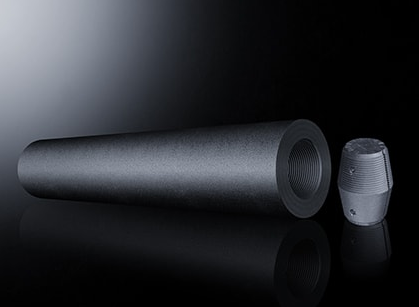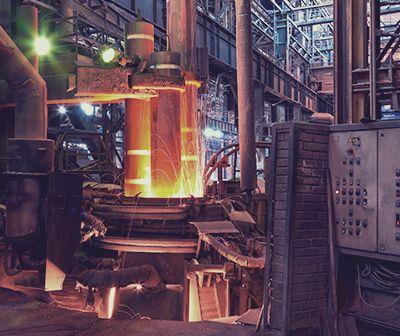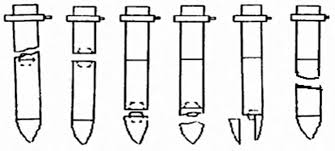Home > News > Reasons why graphite electrodes break during the smelting process and preventive measures
The normal use of graphite electrodes during the steelmaking process is an important guarantee for the stable operation of electric furnace steelmaking. During the smelting process, inherent quality problems of the electrode, improper smelting operations, and matching problems between the two can easily lead to electrode breakage accidents.

According to the internal and external factors affecting the electrode during the smelting process, electrode breakage can be summarized into the following three categories: operational reasons, control reasons, and electrode quality reasons.
1. Reasons for operation
(1) The collapsing material breaks the electrode.
If the scrap steel in the furnace has formed a bridge structure during the smelting process, especially when it is close to melting, the short arc operation for a long time at this time will produce a large lateral impact force of the collapsed material; an important feature when such an accident occurs is that the electrode The clamping point receives the largest acting moment, and the probability of breakage near the electrode clamping point is greatest.
(2) Resonance breaks the electrode.
If the mechanical vibration frequency of the electrode column is close to or synchronized with the electromagnetic force vibration frequency, the electrode will resonate and easily lead to fatigue fracture of the electrode. The breakage of electrodes (connectors) caused by such reasons often has no specific pattern and mostly occurs at loose electrodes.
(3) Irregular clamping operation leads to broken electrodes.
If the electrode and the holder cannot be kept vertical, the electrode will have an additional horizontal force component; if there are foreign objects on the clamping surface, stress concentration will easily occur at the clamping point; if the electrode connection is poor, the mechanical strength of the electrode at the connection interface cannot meet the load. force requirements. These poor operations can easily cause the electrode to break during the smelting process.

2.Control reasons
(1) There are non-conductive objects under the electrodes in the furnace.
During the process of electrode driving down, after the lower end of the electrode comes into contact with a non-conductive object, the electrode regulator cannot accurately judge that the electrode has dropped to the position, but the electrode regulator controls the electrode to continue to fall, causing the electrode and scrap steel to be squeezed and broken longitudinally.
(2) The electrode regulator cannot detect the decrease in the phase-to-ground voltage.
Under normal circumstances, when the lower end of a certain phase electrode automatically drops and contacts the scrap steel in the furnace, the secondary voltage of that phase should drop to less than 20% of the no-load voltage or lower. However, if the neutral point of the voltage transformer is connected to the bottom shell of the electric furnace, If the line is disconnected, the electrode regulator cannot detect the decrease in the phase-to-ground voltage and cannot judge that the electrode has dropped to the position, causing the electrode regulator to control the electrode to continue to fall, causing the electrode to be squeezed and broken from the scrap steel. The main characteristics of this kind of fault are: if there is no arc, the first electrode will always break. After the first phase electrode drops and contacts the scrap steel, the secondary voltage of the phase electrode remains basically unchanged.
(3) The electrode regulator cannot detect the arc current
Under normal circumstances, when the lower end of a certain phase electrode automatically drops and contacts the scrap steel in the furnace, the secondary ground voltage of this phase will immediately drop below 20% of the no-load voltage. The phase electrode will immediately stop falling and wait for the second phase electrode to drop until it starts. arc. If the electrode regulator cannot detect the arc current after the electrode arcs, or the arc current is very small, the electrode regulator will control the second phase electrode to continue to fall, which will cause the second phase electrode to be extruded and broken by the scrap steel. The main characteristic of this kind of fault is that the second or third electrode always breaks after the electrode arcs.
(4) The hydraulic drive mechanism of the electrode regulator is in abnormal condition.
During the automatic descent of the electrode, when the lower end of a certain phase electrode contacts the scrap steel in the furnace, the electrode of that phase should stop descending immediately. If the braking force of the hydraulic drive mechanism becomes smaller or the delay coefficient setting of the system becomes larger, the action of the electrode actuator will be delayed and the electrode end may collide with the scrap steel, causing the electrode to break. This kind of broken electrode failure is random. When the electrode hydraulic drive mechanism is in abnormal condition, the main characteristics of this failure are extreme imbalance, instability and large fluctuations in the three-phase electrode load current during the smelting process.

3. Electrode quality reasons
(1) Reasons for joint breakage:
Joints play a key role in connecting electrodes during steelmaking, and the quality of the joints is directly related to the use of electrodes in electric furnace steelmaking. The connection area formed by graphite electrodes and joints is a site subject to large and complex electrical, thermal, and mechanical loads, and is also a common site of fracture. According to relevant data, more than 80% of electrode accidents in electric furnace steelmaking are caused by broken joints. Or caused by loose tripping. As far as the quality of the joint itself is concerned, the main reasons for breakage are as follows: the joint volume density is low, so the strength is generally low, and it is easy to break during use; the specific resistance is high, and the temperature of the joint part rises quickly when power is turned on, which will cause This causes greater thermal stress at the joints at the electrode connections and increases the probability of breakage; the flexural strength of the joints is insufficient; internally cracked joints are mixed into the finished joints, causing major hidden dangers; the joints and electrode processing accuracy indicators are not reasonably matched, and it is easy to occur Breaking phenomenon.
(2) Reasons for electrode breakage:
Generally, the probability of electrode breakage is low. The main reasons for electrode breakage are as follows: the electrode screw hole has quality defects; the electrode's volume density and strength are insufficient; the electrode and joint specifications and processing accuracy do not match; the electrode end produces Deep cracks are caused by poor thermal shock resistance of the electrode; in addition, electrodes with internal transverse cracks are mixed into the finished product without being detected, and there is a great risk of breakage.

1. Preventive measures against breakage due to operating reasons
(1) Reasonable distribution structure: The distribution of various scrap steel materials in the basket and the conditions of adding them into the furnace must be reasonably configured to prevent light and thin steel materials from forming a ball on the top of the furnace and making it difficult to go down, and to avoid large pieces of scrap steel from collapsing and causing power outages. pole.
(2) During smelting, especially when it is close to melting, the distribution of unmelted furnace materials should be carefully observed. If a bridging structure has been formed, oxygen blowing or physical swinging or shaking should be used first to allow the furnace materials to reach a high position during power outages and the electrodes have been raised. It will collapse in case of collapse to prevent the collapse of the material from breaking the electrode.
(3) The electrode should be of strength suitable for the process requirements. Use nuts of appropriate strength to connect electrodes, clean them, and use special clamping tools. Before replacing the electrode and lifting, the lifting ring must be tightened to ensure that the lifting ring is in close contact with the electrode. To ensure the cleanliness of the interface, it is required to keep the end cap of the new electrode until the lifting ring is installed.
(4) The electrode holder should avoid being caught in the white line between the electrode connections. The electrode connection must not be above the electrode holder. The electrode holder cannot be clamped on an open socket or a socket with a lifting ring.
2. Control causes and preventive measures for breakage
(1) After high-voltage power is transmitted, it is necessary to observe whether the three-phase no-load voltage of the secondary short network is balanced (determined by the insulation resistance of the three-phase short network to ground, the unbalanced voltage should be within 10%).
(2) Before the electrode automatically lowers, confirm that there are no non-conductive objects in the scrap steel layer directly under the electrode.
(3) After the first phase electrode drops and contacts the scrap steel, observe whether the secondary voltage of the phase electrode drops immediately.
(4) When an arc occurs in a certain phase electrode, can the secondary current display of that phase electrode be seen (the ammeter pointer has a large swing).
(5) Regularly detect whether the braking force of the electrode hydraulic drive mechanism and the system delay coefficient have changed.
3. Preventive measures for electrodes to break due to internal quality reasons
Many scholars have conducted more detailed research on the impact of key technical indicators of electrodes (joints) on electrode breakage during the smelting process. It is worth mentioning that the China Carbon Industry Association has conducted product quality spot checks on member companies, and compared the testing indicators of product spot checks with national standards and world-famous carbon companies such as SGL, Yuka, Nippon Carbon, and Tokai Japan. A comparative analysis was conducted against the corporate standards. Judging from the testing indicators, most of the indicators of the tested products comply with the YB-2000 standard, and some indicators have reached or are close to the corporate standards of the world's four famous carbon companies. However, the actual smelting effect of domestic ultra-high-power graphite electrodes is significantly different from that of foreign products of the same specifications. Therefore, it is one-sided to judge the quality of electrodes (joints) based solely on the physical and chemical indicators of the electrodes (joints). This should be fully considered. We will establish a set of scientific and reasonable electrode production and technical usage plans based on the compatibility of the factory's products with the smelting processes, furnace structures, smelting steel types and other comprehensive factors of different customers.
